
|

1986 RECIPIENT
Bill Reid — Metalsmith, Wood Carver, Jeweller
About the craftsperson
|
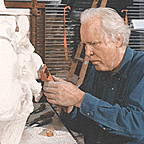
|
"What sort of an artist is Bill Reid? Sculptor, carver, jeweller,
printmaker — all of these, and poet also. Few great artists are witty,
fewer still are gifted wordsmiths. For Bill, words are like the gold and
the cedar he works into the forms of myth, history and imagination. His
mastery gained from many sources, he was confined to none and could work
freely and creatively with different traditions. Undoubtedly the traditions
of Haida art are closest to him, but the conventions of Haida and other
Northwest Coast sculpture were constantly expanding and Bill has further
enriched them. The major strengths of traditional Northwest Coast art lay
in sculpture and oratory. In his sculpture and in his jewellery, Bill has
given new forms to the myth and a different expression to the wit. Bill is
an artist extraordinary."
Harry Hawthorn
Emeritus professor of anthropology
University of British Columbia
Vancouver
|
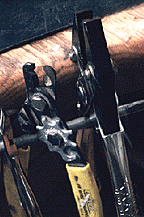
|
Bill Reid, one of Canada's foremost metalsmiths, has played an important
part in the movement to call attention to the great artistic achievements
of Canada's native peoples. Born of Haida-Indian and Scottish-American
parentage, Reid did not know that he was "anything other than an average
Caucasian North American" until he was in his early teens.
In 1943, in an effort to discover the traditions of his maternal ancestors,
Reid made the first of what have become annual pilgrimages to the Haida
village of Skidegate in the Queen Charlotte Islands. There he visited with
his grandfather, Charles Gladstone, a top-notch boat builder who had been
an apprentice of Charles Edenshaw, the great nineteenth-century Haida
carver and silversmith.
|
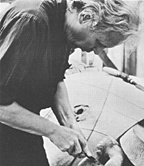
|
Bill Reid carving a Haida pole,
Skidegate, Queen Charlotte Islands,
1977
|

|
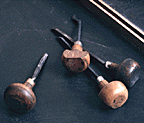
|
Reid's grandfather, who was Edenshaw's nephew, stood last in a direct line
of Haida makers of silver jewellery. Fascinated by Haida design, Reid began
exploring its structure through training and experimentation in
European-style jewellery making.
He gradually moved away from his career as a CBC broadcaster toward that of
artist. He has designed and made gold and silver jewellery, has done wood
carving, designed silk-screen prints, and written and illustrated books.
|
|
In striving to understand and share the structure and meaning of Haida art,
Reid has passed along his passion and his knowledge to a new generation of
Northwest Coast artists. While most of their production is destined tor the
marketplace, an increasing number of works are being created for the native
community for ceremonial use and as potlatch gifts.
|
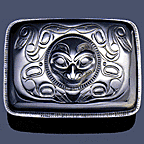
|
Lidded Box with Bear Design, 1985-86
Silver, leather lining
Chased, constructed
11.8 cm x 8.8 cm x 5.5 cm
CMC 86-41.1 to 2
Massey Foundation Collection
|

|
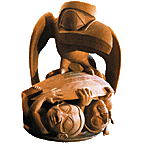
|
Raven Discovering Mankind in a
Clamshell, 1970
Boxwood
Carved
7.0 cm x 6.9 cm x 5.5 cm
Collection: Museum of Anthropology,
University of British Columbia, Vancouver
|

|

|
While Reid admits to playing a part in the regeneration of aspects of
native heritage, he is as aware as anyone that a true cultural revival
involves a commitment to land rights and to political and social
development. His own opposition to the logging of the Queen Charlottes and
his attempts to involve Haida communities in projects like canoe building
express his commitment.
The work of Bill Reid, and that of younger artists who have been inspired
by his example, has become the focus of positive new discussions between
native and non-native communities. As a museum curator and writer, Reid has
helped to reveal the artistic achievements of the Haida.
In his large-scale projects, he has set in motion the collaboration of
skilled carvers and other craftspeople from a variety of traditions. Reid's
commitment to craftsmanship evidently goes beyond any particular culture or
ethnic group. He points to the crucial role of the maker in a world
where we more and more seek out and admire the finely crafted object, [but]
we less and less know how to make it.
Reid speaks with the faith of all great craftspeople when he asserts:
"Once we discard our ethnocentric hierarchical ideas about the way the
world works, we will find that one basic quality unites all the works of
mankind that speak to us in human, recognizable voices across the barriers
of time, culture and space: the simple quality of being well made".
|
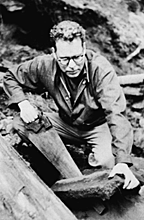
|
Bill Reid sawing a block of
argillite, Queen Charlotte Islands,
late 1950s
|

|

